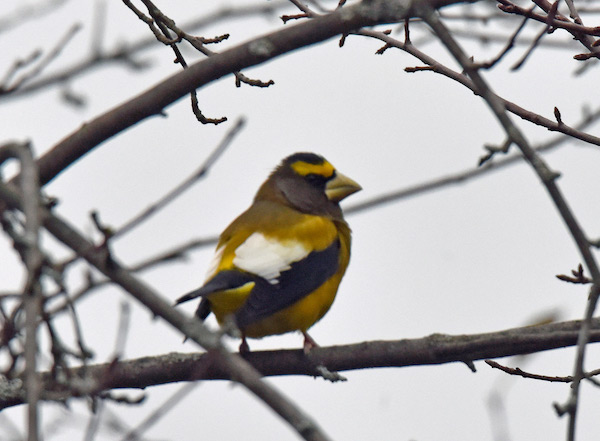Volunteers will be out Dec. 28 for annual bird count at Oak Orchard Swamp

Photos courtesy of Celeste Morien: This Mallard is pictured at the Iroquois National Wildlife Refuge.
Press Release, Oak Orchard Christmas Bird Count Compiler Celeste Morien
SHELBY – It’s time again for the Oak Orchard Swamp Christmas Bird Count! The count began in December 1968. The National Audubon Society has been sponsoring Christmas Bird Counts for 120 years and the Friends of Iroquois National Wildlife Refuge provide support for this local count.
Count compiler Celeste Morien of Medina would like the public to be alert for counters with spotting scopes and binoculars who will be out and about December 28th on local roads, searching for birds in fields and at bird feeders.

Brown Creeper
Filling bird feeders now and keeping them stocked ahead of the count helps fulfill the count objective of counting all wild birds seen and heard within the circle! Our Oak Orchard Swamp count is centered at the Iroquois National Wildlife Refuge on the Orleans and Genesee County line at Route 63.
Count volunteers follow specified routes through a designated 15-mile diameter circle, which includes more than the refuge and state wildlife areas, counting every bird they see or hear all day. It’s not just a species tally—all birds are counted all day, giving an indication of the total number of birds in the circle that day.
According to the Audubon website, “Prior to the turn of the 20th century, hunters engaged in a holiday tradition known as the Christmas “Side Hunt.” They would choose sides and go afield with their guns—whoever brought in the biggest pile of feathered (and furred) quarry won.
Conservation was in its beginning stages in that era, and many observers and scientists were becoming concerned about declining bird populations. Beginning on Christmas Day 1900, ornithologist Frank M. Chapman, an early officer in the then-nascent Audubon Society, proposed a new holiday tradition—a “Christmas Bird Census” that would count birds during the holidays rather than hunt them.
So began the Christmas Bird Count. Thanks to the inspiration of Chapman and the enthusiasm of 27 dedicated birders, 25 Christmas Bird Counts were held that day. The locations ranged from Toronto, Ontario to Pacific Grove, California with most counts in or near the population centers of northeastern North America.
Nowadays, from December 14 through January 5 each year, tens of thousands of volunteers throughout the Americas brave snow, wind, or rain, and take part in the effort. Audubon and other organizations use data collected in this long-running wildlife census to assess the health of bird populations, and to help guide conservation action.
The data collected by observers over the past century allow Audubon researchers, conservation biologists, wildlife agencies and other interested individuals to study the long-term health and status of bird populations across North America. When combined with other surveys such as the Breeding Bird Survey, the “CBC” provides a picture of how the continent’s bird populations have changed in time and space over the past hundred years.

Evening Grosbeak
The long term perspective is vital for conservationists. It informs strategies to protect birds and their habitat, and helps identify environmental issues with implications for people as well.
If your home is within the circle and you are at home on count day, you can report the birds that visit your feeder. Anyone can participate, but arrangements must be made with the compiler. To do so, please contact celeste.morien@gmail.com.
Please consider donating to the Christmas Count (click here) since the Audubon Society no longer collects fees from each participant.
13,000 birds were counted at last year’s event
There were 21 volunteers at last year’s event and they counted 62 species and 13,248 individual birds, including 20 Bald Eagles and 493 Herring Gulls.
A list of species at last year’s count includes:
- Canada Goose, 4,447; European Starling, 4,105; House Sparrow, 690; Rock Pigeon (Feral Pigeon), 499; Herring Gull, 493; Mallard, 327;
- Ring-billed Gull, 307; Black-capped Chickadee; 287; American Crow, 270; Mourning Dove, 173; Red-winged Blackbird, 151; American Tree Sparrow, 142;
- Dark-eyed Junco, 140; Brown-headed Cowbird, 139; American Goldfinch, 127; Northern Cardinal, 109; Blue Jay, 102; Cedar Waxwing, 85; Downy Woodpecker, 83;
- White-Breasted Nuthatch, 73; House Finch, 62; Eastern Bluebird, 48; Wild Turkey, 48; Red-tailed Hawk, 47; Red-bellied Woodpecker, 46; American Black Duck, 31;
- Hairy Woodpecker, 30; Northern Flicker, 29; American Robin, 22; White-throated Sparrow, 21; Bald Eagle, 20; Tufted Titmouse, 17; Horned Lark, 10; Song Sparrow, 9;
- Brown Creeper, 9; Pileated Woodpecker, 8; Golden-crowned Kinglet, 5; Eastern Screech Owl, 5; Cooper’s Hawk, 5; Northern Harrier, 4; Red-breasted Nuthatch, 3; American Kestral, 3; Sharp-shinned Hawk, 3; Great Blue Heron, 3; Ring-necked Pheasant, 3;
- Carolina Wren, 2; Common Raven, 2; Merlin, 2; Great Horned Owl, 2; Common Merganser, 2;
- Yellow-Romped Warbler, 1; Hermit Thrush, 1; Ruby-crowned Kinglet, 1; Northern Shrike, 1; and Barred Owl, 1.




































































